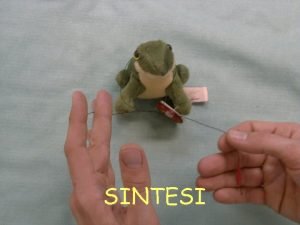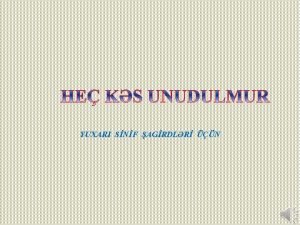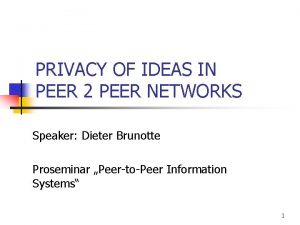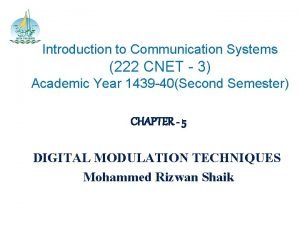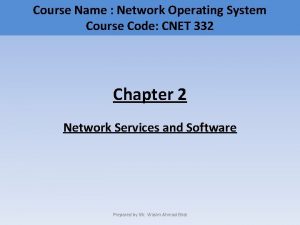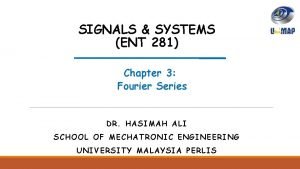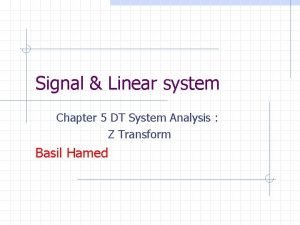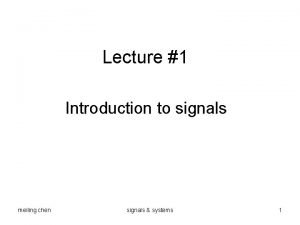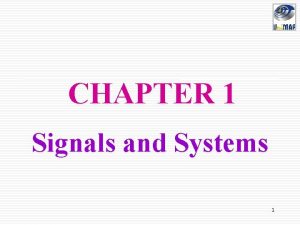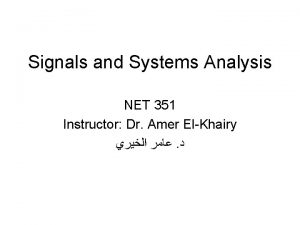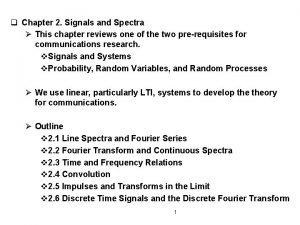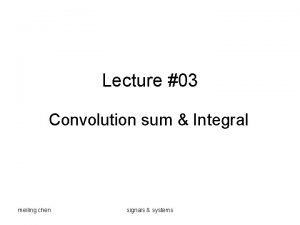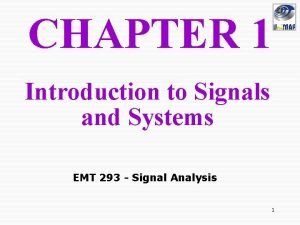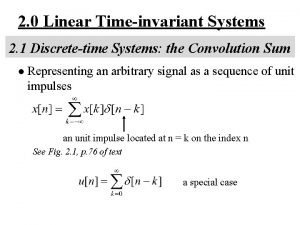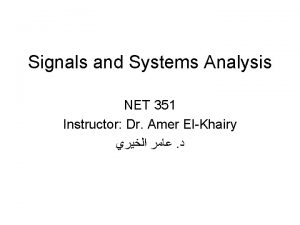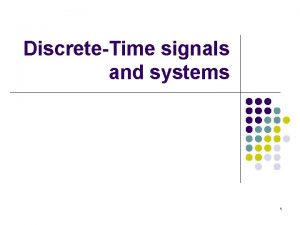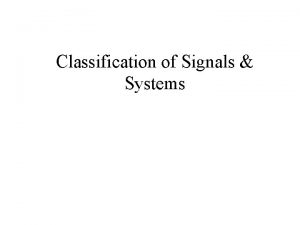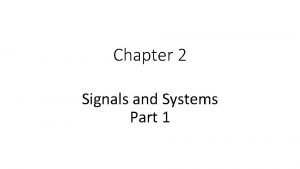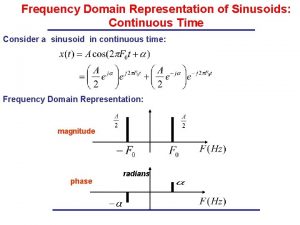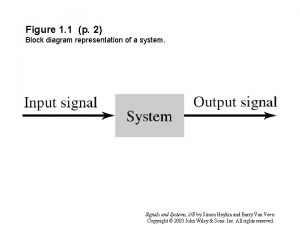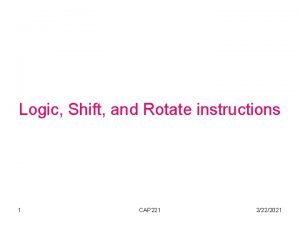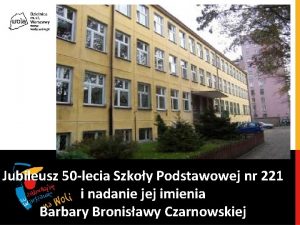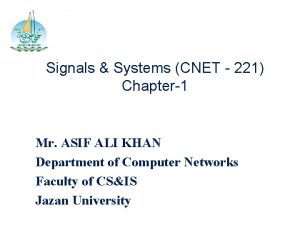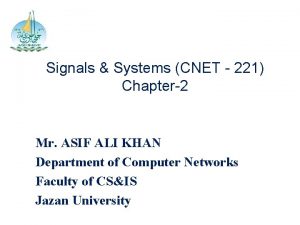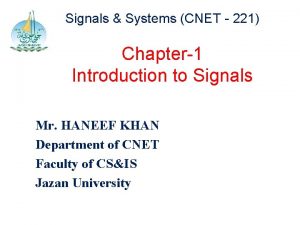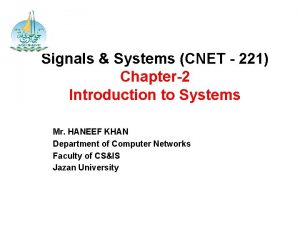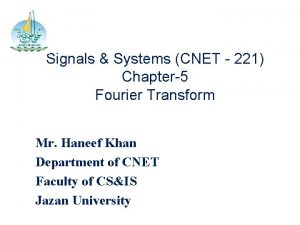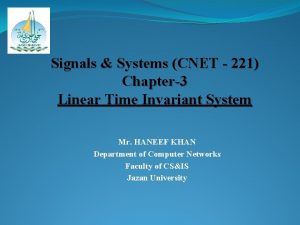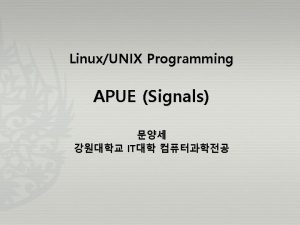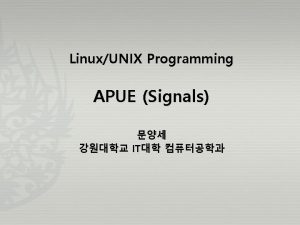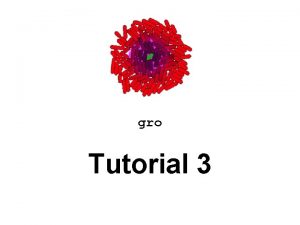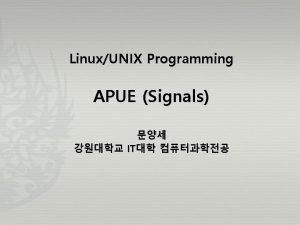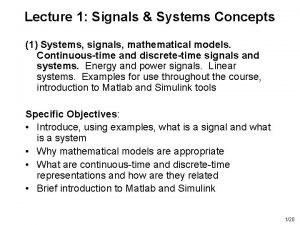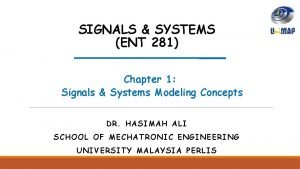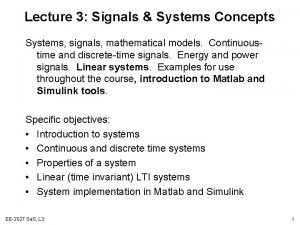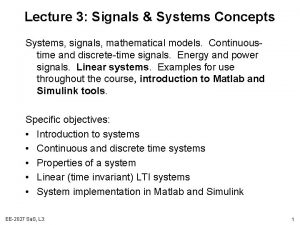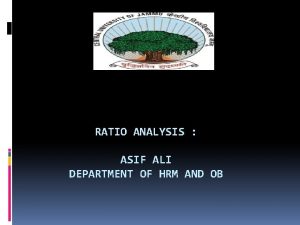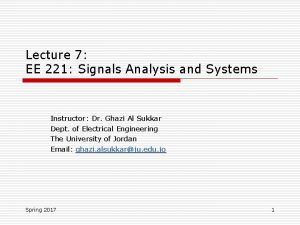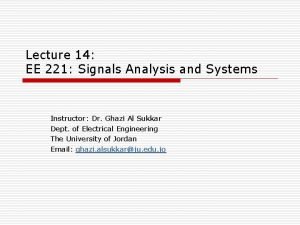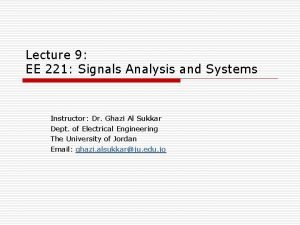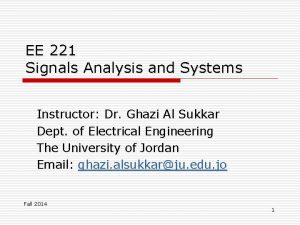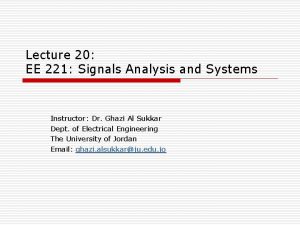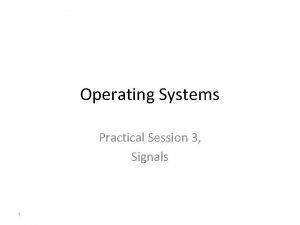Signals Systems CNET 221 Chapter4 Mr ASIF ALI




































- Slides: 36

Signals & Systems (CNET - 221) Chapter-4 Mr. ASIF ALI KHAN Department of Computer Networks Faculty of CS&IS Jazan University

Chapter Objective Following are the objectives of Chapter-III Ø Ø Continuous and Discrete LTI Systems Representation of signal in terms of impulses Unit Impulse Signal response & Convolution LTI System Properties PAGE : 192 Examples : 3. 2, 3. 3, 3. 4, 3. 5

Course Description-Chapter-4 Fourier Series 4. 1 Introduction Fourier Series Representation Of Continuous- Time Signals 4. 2 Fourier Series Representation of Continuous -Time Periodic Signals 4. 2. 1 Linear Combination of Harmonically related complex Exponentials 4. 2. 2 Determination of the Fourier Series Representation of a Continuous-Time Periodic Signal 4. 3 Convergence of the Fourier Series 4. 4 Properties of Continuous-Time Fourier Series Linearity, Time Shifting , Time Reversal , Time Scaling , Multiplication , Conjugation and Conjugate Symmetry, Parseval's Relation 4. 5 Fourier Series Representation of Discrete-Time Periodic Signals 4. 5. 1 Linear Combination of harmonically related complex exponentials 4. 5. 2 Determination of the Fourier Series Representation of a Periodic Signal

Fourier Series Fourier series is just a means to represent a periodic signal as an infinite sum of sine wave components.

Fourier Series-Decomposition

Example (Square Wave) f(t) 1 -6 -5 -4 -3 -2 - 2 3 4 5

Harmonics

Harmonics……. Continued

Harmonics……. Continued

Complex Exponentials

Complex Form of the Fourier Series

Complex Form of the Fourier Series

Complex Form of the Fourier Series

Complex Form of the Fourier Series

Complex Frequency Spectra

Example f(t) A t

Example A/5 -120 -15 0 -80 -10 0 -40 -5 0 0 40 5 0 80 10 0 120 15 0

Example A/10 -120 -80 -40 -30 0 -20 0 -10 0 0 40 80 120 10 0 20 0 30 0

Convergence of the CTFS

Convergence of the CTFS

Convergence of the CTFS

CTFS Properties

CTFS Properties………Continued

CTFS Properties………Continued

CTFS Properties………Continued

CTFS Properties………Continued

CTFS Properties………Continued

CTFS Properties………Continued

CTFS Properties………Continued

CTFS Properties………Continued

CTFS Properties………Continued

CTFS Properties………Continued

CTFS Properties………Continued

Some Common CTFS Pairs

Parseval’s Theorem Ø Let x(t) be a periodic signal with period T Ø The average power P of the signal is defined as Ø Expressing the signal as it is also

Videos 1. https: //www. youtube. com/watch? v=7 Z 3 LE 5 u. M 6 Y&list=PLb. MVog. Vj 5 n. JQQZbah 2 u. RZIRZ_9 kfoq. Zyx 2. Signals & Systems Tutorial https: //www. youtube. com/watch? v=y. Lez. P 5 ziz 0 U&list=PL 56 ED 47 DCECCD 69 B 2
 Minahil asif
Minahil asif Ltad nedir
Ltad nedir Barrel chest
Barrel chest Amir asif
Amir asif 1 prolene suture
1 prolene suture Asif international
Asif international Asif əsgərov
Asif əsgərov Communicative signals and informative signals
Communicative signals and informative signals Informative signals example
Informative signals example Communicative signals and informative signals
Communicative signals and informative signals Cnet communication
Cnet communication Visual commerce syndication
Visual commerce syndication Cnet
Cnet Cnet3
Cnet3 Cnet ftp
Cnet ftp Fouries
Fouries Signals and systems oppenheim solutions chapter 5
Signals and systems oppenheim solutions chapter 5 Precedence rule in signals and systems
Precedence rule in signals and systems Precedence rule in signals and systems
Precedence rule in signals and systems Convolution sum in signals and systems
Convolution sum in signals and systems Pulse train fourier transform
Pulse train fourier transform Convolution sum signals and systems
Convolution sum signals and systems Introduction to signals and systems
Introduction to signals and systems Convolution sum in signals and systems
Convolution sum in signals and systems Sinusoidal signal
Sinusoidal signal Signal and systems
Signal and systems Tri function
Tri function Signal and systems
Signal and systems Time frequency domain
Time frequency domain Signals and systems
Signals and systems Csce 221 tamu syllabus
Csce 221 tamu syllabus Phy 221 msu
Phy 221 msu People first timesheet
People first timesheet Cap 221
Cap 221 Sp 221
Sp 221 Emmett bond results
Emmett bond results Epsc 221
Epsc 221




